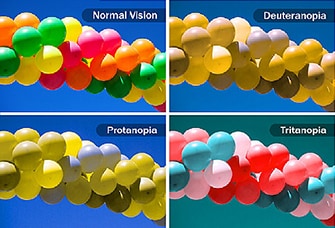
- Color blindness also known as color vision deficiency is the inability of a person to see colors in a normal way.
- Color blindness can occur when one or more of the color cone cells (for red, green and blue) are absent, not working, or detect a different color than normal.
- People with color blindness cannot distinguish between certain colors which usually occur between greens and reds, and occasionally blues.
- Red-green color blindness is a sex-linked (X-linked) disease, more common in men. Blue-yellow color blindness and complete color blindness (very rare) are passed down on other chromosomes, so they affect males and females equally.
Types of color blindness:
- Red-green color blindness:
- There is difficulty in seeing the difference between red and green which is further of four types.
- The most common type is Deuteranomaly which is mild. It makes green look redder. They may even mistake purple for blue.
- Protanomaly is also a mild type in which red looks greener and less bright.
- In Protanopia and Deuteranopia, a person is completely unable to tell the difference between red and green.
- Blue-yellow color blindness:
- It is the difficulty in seeing the difference between blue and green, and between yellow and red. It is further of two types:
- In Tritanomaly it is hard to tell the difference between blue and green, and between yellow and red.
- Tritanopia makes a person unable to tell the difference between blue and green, purple and red, and yellow and pink. It also makes colors look less bright.
- Complete color blindness:
- This is the inability of a person to see any color at all and to see everything only in shades of gray. Is is called monochromacy or achromatopsia. This rare condition is often associated with; amblyopia (or lazy eye), nystagmus (repetitive uncontrolled movement of eye), light sensitivity, and poor vision.
Causes of color blindness:
- Most people have color blindness since birth. i. e. it is a congenital genetic condition. Red-green color blindness usually passes from mother to son through X-chromosome whereas, blue-yellow color blindness and complete color blindness are passed down on other chromosomes.
- Many color vision defects might occur later in life as a result of:
- Eye or brain injuries because of trauma
- Eye diseases, like glaucoma or macular degeneration
- Toxic effects of drugs
- Brain and nervous system diseases like Alzheimer’s or multiple sclerosis
- Metabolic and vascular diseases
Symptoms of color blindness:
- The degree of color blindness may vary and so are the symptoms. Symptoms can range from mild to severe. Many people show mild symptoms without even knowing that they have a color vision deficiency.
- A color blind person might have trouble seeing:
- the colors in dim light (but have normal color vision in good light)
- difference between colors in any light
- how bright the colors are
- the difference in shades and tones of the same color
Diagnosis of color blindness:
- Color blindness can be diagnosed by various methods or tests:
1. Color plate test or The Ishihara Test:
-
- Most common type of color blindness test
- The eye doctor shows us a pattern made up of multi-colored dots.
- If we don’t have a color deficiency, we will be able to see numbers and shapes among the dots.
- If we are color blind, we will have a hard time finding the number or shape in the pattern. We may not see anything in the pattern at all.

2. Anomaloscope Test:
-
- This test will check if we can match the brightness of two lights.
- We will look into an eyepiece at 2 lights that have different levels of brightness.
- We will use knobs to adjust the lights and try to get them to match.
- If we aren’t able to match the brightness of the 2 lights, we may have color blindness.
3. Hue Test:
-
- In a hue test, we will get blocks with different colors.
- Our eye doctor will ask us to arrange them in rainbow order, like from red to purple.
- If we have trouble putting them in the correct order, we may have a type of color blindness.
- People who need to have very accurate color vision for their jobs, like photographers or designers are tested for color blindness by this method.
Treatment or Correction:
- Congenital color blindness doesn’t have any treatment. It usually does not cause any significant disability.
- However, there are special contact lenses and monochromatic glasses (glasses with filters) that may help.
- If the color blindness is not congenital and happening because of other health problems, we will have to treat the condition that’s causing the problem.
Color blindness (Types, Causes, Symptoms, Diagnosis, and Treatment)
References:
- https://www.aao.org/eye-health/diseases/what-is-color-blindness
- https://www.nei.nih.gov/learn-about-eye-health/eye-conditions-and-diseases/color-blindness